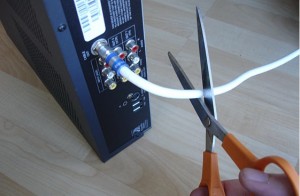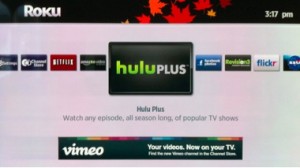Liveness with a Lag: Temporality & Streaming Television [Part 1]
 I am in the process of concluding a year-long experiment in cord-cutting. Upon moving into a new apartment in the spring of 2011, I wanted to reduce costs by streaming television over the Internet rather than paying for cable. I invested in a Roku box, which allowed me to connect the Internet directly to my television, and signed up for Hulu Plus and Netflix’s streaming service. My savings were immediate and dramatic; I saved nearly $60 a month by cutting the cable cord.
I am in the process of concluding a year-long experiment in cord-cutting. Upon moving into a new apartment in the spring of 2011, I wanted to reduce costs by streaming television over the Internet rather than paying for cable. I invested in a Roku box, which allowed me to connect the Internet directly to my television, and signed up for Hulu Plus and Netflix’s streaming service. My savings were immediate and dramatic; I saved nearly $60 a month by cutting the cable cord.
Mission accomplished? Kind of. This isn’t a story that can be boiled down to dollars and cents, though. Streaming television over the Internet involves many continuities with how I’d consumed TV for decades prior. But it also precipitated important changes in my consumption habits that warrant mention here. These continuities and differences are imbricated in developing industry practices related to the release of television content online, as well as technological developments in the convergence of television and the Internet via digital devices.
I follow Tara McPherson’s lead in “Reload: Liveness, Mobility, and the Web” where she describes the experience of consuming media in digital environments. In that essay, McPherson is interested in “exploring the specificity of the experience of using the web, of the web as mediator between human and machine, of the web as a technology of experience” so that she may describe the phenomenology of using the Internet to screen moving image media (460). My focus is on one iteration of the activities she describes: watching television over the Internet via a Roku box. Like McPherson, I am interested in the ways that “new” technology both continue and confound the experience of “old” media: what feels different and what changes, but also what feels similar and what remains the same. More pointedly, I want to use McPherson’s thoughts to explicate the feelings of liveness that attend streaming television online.
 Receiving a television signal over the Internet via Roku involves several residual elements of television practice. With a Roku box, the consumer browses from a menu, selecting which services to add: Hulu, Netflix, Amazon, Crackle, and so on. This feels similar to picking service packages from a cable company: premium vs. basic, etc. Once these “channels” are chosen, Roku users can browse within them for content. This too is reminiscent of more traditional modes of television viewing; it’s like “zapping” until you find something you like—Roku even provides an “old school” remote. After a program is selected, the television screen goes blank and loads the program like an Internet clip, complete with a “Loading, Please Wait…” message. When this would happen, I felt as though I was waiting for commercials to end and “the real program” to start. Thus, protocols for TV distribution and reception developed in earlier contexts continue to shape viewers’ experiences with the medium in the instance of streaming TV online. Well-established paradigms for television spectatorship—changing channels, browsing for programs, waiting for a narrative to begin—still shape the practice of viewing television with a Roku box.
Receiving a television signal over the Internet via Roku involves several residual elements of television practice. With a Roku box, the consumer browses from a menu, selecting which services to add: Hulu, Netflix, Amazon, Crackle, and so on. This feels similar to picking service packages from a cable company: premium vs. basic, etc. Once these “channels” are chosen, Roku users can browse within them for content. This too is reminiscent of more traditional modes of television viewing; it’s like “zapping” until you find something you like—Roku even provides an “old school” remote. After a program is selected, the television screen goes blank and loads the program like an Internet clip, complete with a “Loading, Please Wait…” message. When this would happen, I felt as though I was waiting for commercials to end and “the real program” to start. Thus, protocols for TV distribution and reception developed in earlier contexts continue to shape viewers’ experiences with the medium in the instance of streaming TV online. Well-established paradigms for television spectatorship—changing channels, browsing for programs, waiting for a narrative to begin—still shape the practice of viewing television with a Roku box.
Yet for all of the continuities with prior modes of consuming television, my viewing experiences changed dramatically upon installing my Roku. By nature, I am a television grazer. I typically turn on the set and “zap” until I find something I like. But with the Roku, such grazing is more difficult. The technology’s design prevents users from simply turning on the television and finding programming already in progress. With Roku, every time you turn on the TV, you need to select content, wait for it to load, and only then can you actually watch anything. McPherson calls this the “scan and search” nature of web environments, the ways in which users can call up content at will. While this is characteristic of the ways that many people consume moving image media on the Internet, it isn’t characteristic of the way that I typically watch television. If “convergence” is often the term used to describe television practice in the contemporary moment, using a Roku box pointed to the divergence in the ways that I consume television vs. the ways I use the Internet. In part two, I will directly address issues related to available content and liveness.



Thanks Hollis for writing this! I fear that my grazing attitude toward watching television prevents me from “cutting the cord” as well. As much as I do watch television on my computer and other devices, I feel more comfortable with it simply BECAUSE I can turn those off, turn the cable tv on and watch that way.
As one who tends to drop out of TV series after a season or two, “grazing” is my base mode of media consumption. I just find that there aren’t enough hours in the day to keep up with everything I’d like to watch. Once I get the gist of a show, I tend to fall out of it. Unless I’m writing about it or studying it, that is. Too much to pick from!
Very interesting. One thing I find interesting about the selection era is that it negates one of the best things about old school TV which is stumbling onto something you like while “zapping” and just watching it from wherever it is in its programming time. The surprise is better than the selection. Looking forward to Pt 2!
I’m also a cord-cutter and have been thinking through the ways in which my relationship with television has changed. For instance, I find I consume far MORE television now. Series marathons are common, and my preference for serialized narratives has solidified. As I discuss my changing habits with under/graduate students, though, I’ve noticed how many of them have never had a “cord to cut.” That is, their television habits have matured in an era of streaming media–they’re just as comfortable with laptops and tablets as they are with big screen televisions (sometimes, more so). So, there’s an important generational qualification to add here … and I wonder when traditional business models (and the practices they engender) will hit the tipping point and give way to something new.
Generation is a major qualifier for this. I also find that my students are far more comfortable cord-cutting than I was. I don’t know that I consumed more or less television, but the “public” around the things I was viewing felt smaller somehow. It was an affective thing — I felt left out.